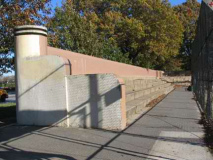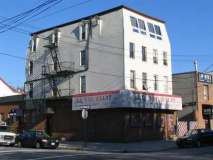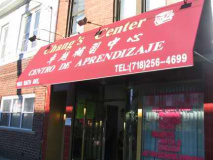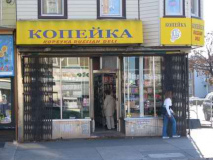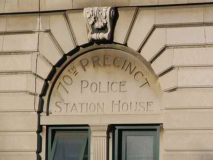CONTINUED FROM WHERE THE STREET HAD NO NAME, PART 1
WAYFARING MAP: FROM DYKER BEACH TO BATH BEACH (open map in a separate window so you can follow my route)
 Where the Street Had No Name
Where the Street Had No Name
For decades, I’ve been fascinated with the broad, 4-lane route that connects 7th Avenue at Poly Place and Cropsey Avenue at 14th Avenue. For most of my time biking it or walking on it, the Department of Transportation has never deigned to post street signs, leaving it nameless.
This had always offended my sense of propriety, since I like to assign everything my own little classification, even though my apartment, with all the research for the Forgottenbook still lying about, looks as if a hurricane hit it.
Mapmakers have struggled with it over the years.
 Brooklyn Eagle map, 1895. Most of this area was still under water; this was just before the golf club arrived. A “Franklin” Avenue connected 7th and Cropsey.
Brooklyn Eagle map, 1895. Most of this area was still under water; this was just before the golf club arrived. A “Franklin” Avenue connected 7th and Cropsey.
 Through most of the 20th Century, most mapmakers (such as Hagstrom) chose to punt, not naming the road at all.
Through most of the 20th Century, most mapmakers (such as Hagstrom) chose to punt, not naming the road at all.
 Google, which gets its information from NAVTEQ, calls it “Poly Place.” Keep that in mind…
Google, which gets its information from NAVTEQ, calls it “Poly Place.” Keep that in mind…
While the NYC Department of Transportation resolutely refused to designate the road (until recently, as we’ll see) theMetropolitan Transit Authority sent definitely mixed signals regarding the road’s name, hence, the “Cropsey Avenue” mark on a bus route sign, and the “Poly Place” designation on a newer one.
 The DOT, however, recently made all discussions moot by designating it Poly Place, an apparent extension of the short street that runs between Battery Avenue and 7th Avenue; it had been taken over by the Army as part of Fort Hamilton in the 1970s and has been closed to the public since then. While it seems to be a natural extension…
The DOT, however, recently made all discussions moot by designating it Poly Place, an apparent extension of the short street that runs between Battery Avenue and 7th Avenue; it had been taken over by the Army as part of Fort Hamilton in the 1970s and has been closed to the public since then. While it seems to be a natural extension…
I propose a formal renaming to…
Woods, a young Army lieutenant colonel stationed at Fort Hamilton, played 17 holes at Dyker Beach Golf Course in 1972, and instantly became hooked on the game.
A few years later, his young son, Eldrick, also began playing, and three decades later, Tiger Woods is the greatest in the game. The elder Woods died in May, 2006, and I believe renaming the busy road adjacent to the course where he first played golf would be a fitting tribute.
Dyker Beach Park
I had not been to this park since I played ball here with the old man in the Swingin’ Sixties, but I had a vague recollection of high concrete walls. I was partly right.
When Dyker Beach Park got its last major renovation in the 30s, Robert Moses had a lot of room to maneuver, and he installed yard after yard of massive concrete stands…
…and acre upon acre of playing fields.
one of the Moderne-style drinking fountains is still there.
 Just over the Bay 8th Street bridge spanning the Belt Parkway is a postcard view of the Verrazano Bridge. Until the 1990s this was one of Brooklyn’s premier kite flying venues, but Rudy Giuliani, responding to accidents caused by rubbernecking motorists as well as pilots of small aircraft, banned the kites though I hear that some can still be found here in spring and summer.
Just over the Bay 8th Street bridge spanning the Belt Parkway is a postcard view of the Verrazano Bridge. Until the 1990s this was one of Brooklyn’s premier kite flying venues, but Rudy Giuliani, responding to accidents caused by rubbernecking motorists as well as pilots of small aircraft, banned the kites though I hear that some can still be found here in spring and summer.
Before 1993 I must have made hundreds of navigations of the bike path along the Narrows, which runs from Caesars Bay Bazaar at Bay Parkway (formerly E.J. Korvettes, one of the first major department stores to come to Brooklyn’s outlying areas) to the 69th Street Pier. The view here is of Coney Island (to prove it, I zoomed in on the iconic Parachute Jump).
Bath Beach
Strangely enough, I haven’t previously explored Bath Beach in depth — as I’ve said when I lived nearby, I always used it as a way to get somewhere else. Mea culpa: Bath Beach is a former well to do seaside resort, and if you look carefully there are still some remnants of its grand past hiding there in the “Bay” streets.
As the NYC Parks Department explains…The neighborhood of Bath Beach is named for the town of Bath, England, home to an impressive complex of Roman baths. The Romans founded the town in the 1st century AD, and named it Aquae Sulfis – “Hot Springs” – because they found hot springs naturally occurring there. The Romans ascribed medicinal effects to the springs and built baths around them; the complex – with a cooling system and lead-lined pools – was discovered, largely intact, in 1755.
Bath Beach itself was once a fashionable retreat. The 1862 construction of the Brooklyn, Bath, and Coney Island Line connected the region with Manhattan, prompting its transformation from a sleepy farming community into a weekend outpost for New York City high society. Throughout New York’s Gilded Age, the shoreline of Bath Beach boasted yacht clubs, villas, and the famous Captain’s Pier Restaurant at the base of 19th Avenue. Bath Beach also had the Bath House resort, opened by Doctors Barley, Rogers, Tillery, and Bard in the late 18th century near Gravesend Bay, and it was a popular destination for convalescents.
In the 1880s, real estate magnate James Lynch bought 350 acres of farmland from the Benson family and incorporated it into his planned suburb of Bensonhurst-by-the-Sea. Present-day Bath Beach encompasses the southern half of this village; the area north of 86th Street lies within the present-day neighborhood of Bensonhurst.
The “Bay” streets can be confusing. They begin not at Bay 1st, but at Bay 7th; the street layout was devised before Dyker Beach Golf Course was completed in 1920, and the system originally began just after 12th Avenue with Bay 1st. When the golf course was filled in all the way to 86th Street on the north and 14th Avenue on the east, “Bay” streets between Bay 1st and Bay 5th were eliminated (there was never a Bay 6th Street). To add to the confusion, the “Bay” streets skip a number when an Avenue is encountered; for example, 14th Avenue takes the place of Bay 6th; then come Bay 7th and 8th, and 15th Avenue replaces Bay 9th, and so on.
That’s OK…Chicago’s numbered streets begin at 8th Street, and the Bronx’s begin at East 132nd (though the Bronx uses Manhattan’s numbering system).
And, as I’ve noted, a lot of streets are subtitled with the names of local heroes. Vincent Gardenia was a well-known actor who played hundreds of roles; perhaps he was most celebrated for playing Dutch Schnell, the manager of the doomed catcher played by Robert deNiro in Bang the Drum Slowly; or perhaps Archie Bunker’s flamboyant neighbor, Frank Lorenzo; or Cher’s father in Moonstruck; or the police inspector who lets Charles Bronson walk for his vigilante activities in Death Wish– if he leaves town.
Rita Blau was a switchboard supervisor at Fiduciary Trust at WTC Tower One, perishing in the terrorist attack of September 11, 2001. Louis Liotta was a longtime photojournalist for the New York Post.
I had to googleize to find information about Rita and Louis; certainly, they and other people memorialized on street signs should have some information about their lives on a plaque placed below the sign. However, they’d almost certainly be vandalized.
A pair of porched Bath Avenue houses.
There’s a mansard-roofed building buried in there under all that aluminum siding. Later, we’ll see what a building like this looked like in a more esthetically-minded age.
Any Bath Beach ForgottenFans want to help me out about who this Crazy Ronnie was?
Salumeria at 16th Avenue. A lot of these pork stores feature pictures of pigs with chef hats. That means they’re depicting the pigs as cannibals. Actually I’m preparing a whole page on food store signs that show animals preparing to eat members of their own species.
When I was wee, Bensonhurst and Bath Beach were about 80% Italian, and if you heard something not in English, it was most likely Italian. These days, you can also hear Chinese, Spanish, Arabic and Russian, and probably a whole lot more.
One of Bath Avenue’s grand old apartment buildings not yet aluminum-sided at Bay 17th.
I haven’t yet found one pool hall since I moved to fab Flushing. I frequented a different one from this picture, further north on Ovington Avenue, when I worked nights in the 1980s. Of course pool is one of the long list of things I cannot do well – I tended to play Pac-Man.
The Italianness of Bath Beach rises to the fore here at 18th Avenue, subtitled for ocean-blue sailor Cristoforo Colombo. At some time in the past this was a handsome brick building, and then the 1970s happened. Opposite is the House of Squid. How’s this for synergy: 18th Avenue would be called Bay 18th Street, if, well, it wasn’t called 18th Avenue. It’s like 40 below being the same temperature in both Fahrenheit and Celsius.
At 18th Avenue there’s a worn sign for Michael Noto’s law firm; I wonder if Noto’s still there. We’ll see more from St. Finbar later.
 At Bay 19th, it’s another one of Bath Avenue’s grand old buildings, this one marred by 21st Century intrusions like cell phone towers and SUV’s.
At Bay 19th, it’s another one of Bath Avenue’s grand old buildings, this one marred by 21st Century intrusions like cell phone towers and SUV’s.
Despite my occasional run-ins with the police (don’t worry, I’m not a criminal, other than wanting to take the occasional photo in the subway, which annoys some cops to no end) I vote for politicians who promise that the endless struggle against real crime and real criminals will proceed unabated. Some police precincts are among the handsomest buildings in the city, with their inerrant practice of placing green lights by the door. According to the Police Museum, “it is believed that the Rattle Watchmen, who patrolled New Amsterdam in the 1650’s, carried lanterns at night with green glass sides in them as a means of identification. When the Watchmen returned to the watch house after patrol, they hung their lantern on a hook by the front door to show people seeking the watchman that he was in the watch house. Today, green lights are hung outside the entrances of Police Precincts as a symbol that the ‘Watch’ is present and vigilant.”
This is the 62nd Precinct, although what was probably once the side door proclaims it as the former 70th (today the 70th is on Lawrence Avenue in Parkville, a few miles to the north.
When were the numbers changed?
This dilapidated building, now a “Muslim youth center,” was once a catering hall. In fact, my cousin Eileen had the reception after her wedding here in 1986. It was the same day Lenny Dykstra hit a game-winning home run against the Astros in the playoffs. After the game, I put on my tuxedo, walked out the door, and ambled across McKinley Park to the wedding at St. Ephrem’s.
Why are catering halls almost uniformly windowless? Because occasionally embarrassing behavior goes on within. I have video footage of your webmaster dancing in this old catering hall. That video will be suppressed. No youtube, nothing.
Lawrence, James and Zachary…meet “Cleaners &.”
Bay 20th Street. Yes, Virginia. There was a time when moderately-priced residential housing was built to be attractive and had some style and a pinch of panache. But we all know that that kind of thing, like rotary phones, washboards, and the complete game, are over.
I was attracted to this brick building on the corner of Benson Avenue and Bay 20th mostly because it has kept what very well could be its original 24-paned door, complete with peeling red paint.
Benson Avenue, and Bensonhurst itself, are named for Egbert Benson (1746-1833), a delegate to the Continental Congress (1784), a U.S. Representative (1789-1793), and an Associate Justice of the New York State Supreme Court (1794-1801) and chief judge in the U.S. Court of Appeals (1802). He was a founder of the New-York Historical Society and its first president, serving from 1804 to 1816, and returned to the Congress from 1812-1813. The Benson family held a lot of property in the area in the mid-1800s when Bath Beach was developed. In a bit of Forgotten New York synergy, Benson died in Jamaica, Queens and is buried in Prospect Cemetery, chronicled on its own FNY page and inTour 15.
 The massive St. Finbar Church is big – so big, in fact, that Bay 19th Street, on its northern flank, takes a little jog to the north. What might have happened is that the church was built before all the streets were laid out, and the street was simply angled away from the church.
The massive St. Finbar Church is big – so big, in fact, that Bay 19th Street, on its northern flank, takes a little jog to the north. What might have happened is that the church was built before all the streets were laid out, and the street was simply angled away from the church.
Finbar (550-620), whose Irish Gaelic name Fionnbharr means “fair head” or “white head” likely had blond hair; he was an Irish monk, founding a monastery that eventually developed into the City of Cork.
We’ll end our Dyker Heights-Bath Beach tour here at 86th Street, where I can catch a train – my feet got tired. This stretch of the el, home to the D and M trains (at least in 2006) is immortalized in cinema in the 70s by The French Connection and Saturday Night Fever.
And speaking of cinema, at Bay 19th and 86th Street we find the old Loew’s Oriental Theatre, built in 1927 by architect Harrison Wiseman in a Moorish theme. It hung on somewhat longer than similar Loew’s theatres around town, only succumbing in 1995.
SOURCES:
Brooklyn: The Way It Was, Brian Merlis, Israelowitz 1995
BUY this book at Amazon.COM
Brooklyn By Name, Leonard Benardo & Jennifer Weiss, New York University Press 2006
BUY this book at Amazon.COM
Photos taken Mon. October 30; page completed Sun., November 5, 2006




